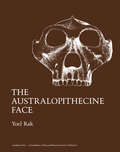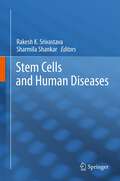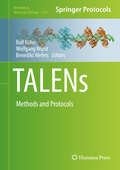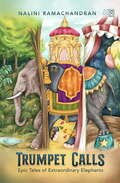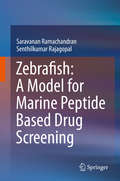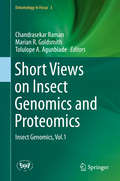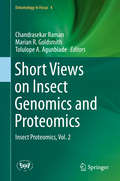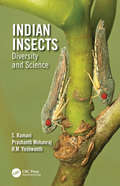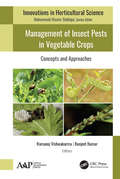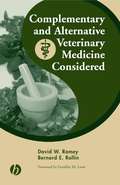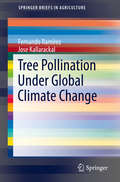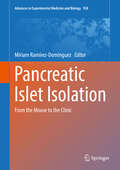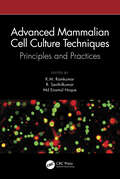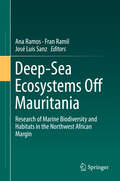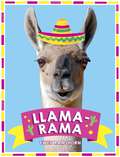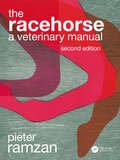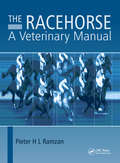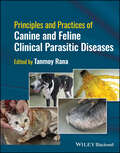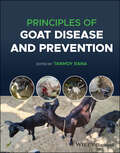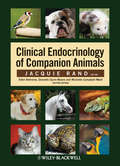- Table View
- List View
The Australopithecine Face
by Yoel RakThe Australopithecine Face provides an introduction to the interpretation of the facial skeleton of Australopithecus, a part of the anatomy well represented in the African collections. This book presents important morphological differences between the early hominid taxa and interprets them in a biochemical, functional, evolutionary framework.Organized into seven chapters, this book begins with an overview of the description of the face of the four species of Australopithecus, extending to comparisons both within the genus and with other primates. This text then provides an analysis of the facial morphology of Australopithecus in terms of structural significance. Other chapters consider the taxonomic and phylogenetic status of the australopithecine species in light of the description and comparison. This book discusses as well the changes in the morphology and topography of the facial mask. The final chapter deals with the phylogenetic assignment of the different species.This book is a valuable resource for anthropologists.
Stem Cells and Human Diseases
by Rakesh Srivastava and Sharmila ShankarThe main objective of this book is to provide a comprehensive review on stem cells and their role in tissue regeneration, homeostasis and therapy. In addition, the role of cancer stem cells in cancer initiation, progression and drug resistance are discussed. The cell signaling pathways and microRNA regulating stem cell self-renewal, tissue homeostasis and drug resistance are also mentioned. Overall, these reviews will provide a new understanding of the influence of stem cells in tissue regeneration, disease regulation, therapy and drug resistance in several human diseases.
TALENs: Methods and Protocols (Methods in Molecular Biology #1338)
by Ralf Kühn, Wolfgang Wurst and Benedikt WefersThis volume provides a comprehensive collection of protocols on new technology across various model organisms. Chapters describe species-specific methods to generate new mutants the content is completed by chapters on natural TAL effectors, TAL element DNA binding principles, TALEN target site prediction, and methods for the efficient construction of TALEN coding regions. While addition chapter focus on the application of TALEN as sequence-specific nucleases and TAL based gene activators or inhibitors and the visualization of chromatin dynamics in live cells. Written in the highly successful Methods in Molecular Biology series format, chapters include introductions to their respective topics, lists of the necessary materials and reagents, step-by-step, readily reproducible laboratory protocols, and tips on troubleshooting and avoiding known pitfalls.Authoritative and cutting-edge, TALENs: Methods and Protocols aims to ensure successful results in the further study of this vital field.
Trumpet Calls: Epic Tales of Extraordinary Elephants
by Nalini RamachandranTo some, elephants are the guardians of forests; to others, they are sacred symbols - worthy of being worshipped. They were comrades-in-arms to kings and queens in one time, and objects of entertainment in another.Drawing from contemporary accounts, world history and mythologies, this enlightening book, peppered with fascinating facts and gorgeous illustrations, explores the complex relationship between elephants and humans across the ages.Here, you will meet elephants who can fly and vanquish nightmares, turn the tide of a battle, trek up mountains and swim like champions, avenge wrongs and form lifelong bonds.Funny, joyful, often profoundly moving and sometimes downright heartbreaking, Trumpet Calls takes you on the wild and wondrous trail of the most majestic creature on earth.
Zebrafish: A Model for Marine Peptide Based Drug Screening
by Saravanan Ramachandran Senthilkumar RajagopalThis book offers a comprehensive overview of toxicology, highlighting the significance of peptide-based toxins from marine environments. It discusses the principles of protein-carbohydrate and domain-domain interactions to increase our understanding of toxicology in zebrafish models, as well as drug interaction mechanisms and target definition in drug discovery. It also reviews the structure of marine peptides/toxins and the toxicology of peptide secreting cells and cells that respond to these enzymes, and describes the normal and abnormal toxicology of marine peptides in zebrafish models. Offering insights into the field of proteomics, particularly current practice and research models for solving its many riddles, the book also explains the analytical principles of marine protein-protein and protein-carbohydrate interaction in the context of teratogenicity in target identification in peptide- based drug discovery. Lastly, the book methodically examines the preclinical research on marine proteins/peptides.
Short Views on Insect Genomics and Proteomics: Insect Genomics, Vol.1 (Entomology in Focus #3)
by Chandrasekar Raman Marian R. Goldsmith Tolulope A. AgunbiadeEntomology as a science of inter-depended branches like molecular entomology, insect biotechnology, has made rapid progress. This also implies that there is an urgent need to manage the available resources. In the past five decades, entomology has taken giant steps ahead. The aim of this work is to integrate perspectives across molecular and biochemistry, physiology, reproduction, developmental biology, molecular evolution, genetics and RNAi applications. This century is proclaimed as the Era of Biotechnology and it consists of all types of Mol-Bio-Gen applications, which is an essential component for a thorough understanding of the insect biology. The aim of this work is to provide the comprehensive review of recent research from various geographic areas around the world and contributing authors that are recognized experts in their respective field of Genomic entomology. This Volume emphasizes upon the need for and relevance of studying molecular aspects of entomology in Universities, Agricultural Universities and other centers of molecular research. It will also serve as a landmark source for Insect advance science technology.
Short Views on Insect Genomics and Proteomics: Insect Proteomics, Vol.2 (Entomology in Focus #4)
by Chandrasekar Raman Marian R. Goldsmith Tolulope A. AgunbiadeEntomology is a super science, embracing interdisciplinary approaches in genomics, proteomics, and interdependent fields of biochemistry, physiology, molecular entomology, and biotechnology. An urgent need to manage available resources for the benefit of the planet and humankind has led to remarkable progress since publication of the fruit fly genome in 2000. “Short Views on Insect Genomics and Proteomics” presents multiple perspectives of recognized experts from around the world in genomics, bioinformatics, molecular biology, biochemistry, physiology, and immunology, emphasizing fast-moving areas of current research on insects and other arthropods. Concise, accessible, topical reviews include body lice and white fly genome projects, aphid phenotypic plasticity, insect regulatory genomics, the complex tick sialome, protein expression systems, therapeutic potential of insect antimicrobial peptides, nanoparticle insecticides, and novel uses for recombinant and synthetic spider silks.
Indian Insects: Diversity and Science
by S. Ramani Prashanth Mohanraj Yeshwanth HmInsects are the most interesting and diverse group of organisms on earth, many of which are useful as pollinators of crops and wild plants while others are useful as natural enemies keeping pestiferous insects in check. It is important to conserve these insects for our survival and for this the diversity of insect species inhabiting the different ecosystems of our country must be known. The cornerstone to studies of any kind of organismal diversity is their taxonomic identity. Even after over two and half centuries of studies, so little is known of the insect wealth of our country. It has contributions from taxonomists who have been studying Indian insects for long, this book offers up to date information on many important groups of Indian insects seeking to fill the lacuna of a long felt need for a comprehensive work on the taxonomy of Indian insects. Salient features: Provides an up-to-date taxonomy of major insect groups of India Presents identification keys with illustrations of several important groups of Indian insects Gives a new insight into why insects are so abundant Addresses fundamental questions in mechanoreception and cross kingdom interactions using insects as model systems Indian Insects: Diversity and Science is a festschrift to Professor C. A. Viraktamath, an insect taxonomist par excellence. It has been designed to cater to the needs of academicians, researchers and students who wish to identify insects collected from local environments and will be an invaluable aid for those working in the areas of systematics, ecology, behaviour, diversity and the conservation of insects.
Indian Insects: Diversity and Science
by S. Ramani Prashanth Mohanraj Yeshwanth HmInsects are the most interesting and diverse group of organisms on earth, many of which are useful as pollinators of crops and wild plants while others are useful as natural enemies keeping pestiferous insects in check. It is important to conserve these insects for our survival and for this the diversity of insect species inhabiting the different ecosystems of our country must be known. The cornerstone to studies of any kind of organismal diversity is their taxonomic identity. Even after over two and half centuries of studies, so little is known of the insect wealth of our country. It has contributions from taxonomists who have been studying Indian insects for long, this book offers up to date information on many important groups of Indian insects seeking to fill the lacuna of a long felt need for a comprehensive work on the taxonomy of Indian insects. Salient features: Provides an up-to-date taxonomy of major insect groups of India Presents identification keys with illustrations of several important groups of Indian insects Gives a new insight into why insects are so abundant Addresses fundamental questions in mechanoreception and cross kingdom interactions using insects as model systems Indian Insects: Diversity and Science is a festschrift to Professor C. A. Viraktamath, an insect taxonomist par excellence. It has been designed to cater to the needs of academicians, researchers and students who wish to identify insects collected from local environments and will be an invaluable aid for those working in the areas of systematics, ecology, behaviour, diversity and the conservation of insects.
Management of Insect Pests in Vegetable Crops: Concepts and Approaches
by Ramanuj Vishwakarma; Ranjeet KumarThis new book on the sustainable management of insect pests in important vegetables offers valuable management strategies in detail. It focuses on eco-friendly technology and approaches to mitigating the damage caused by insect pests with special reference to newer insecticides. Chapters in the volume provide an introduction to vegetable entomology and go on to present a plethora of research on sustainable eco-friendly pest management strategies for root vegetables, spice crops, tuber crops, and more.Vegetable crops that are infested by several insect pests from the nursery to the harvesting stage cause enormous crop losses. Given that it is estimated that up to 40 percent of global crops are lost to agricultural pests each year, new research on effective management strategies is vital. The valuable information provided in this book will be very helpful for faculty and advanced-level students, scientists and researchers, policymakers, and others involved in pest management for vegetable crops.
Complementary and Alternative Veterinary Medicine Considered
by David W. Ramey Bernard E. RollinComplementary and Alternative Veterinary Medicine Considered is a book that belongs in your veterinary library. If you are a veterinarian wondering if you should incorporate complementary and alternative veterinary medicine (CAVM) into your practice, if you have recently hired an associate eager to try such things as acupuncture or homeopathy, or if you have clients asking you about chiropractic, herbal, or magnetic field therapy for their pets, you’ll want to understand the history, science and ethics behind such therapies. In its 2001 Guidelines for Complementary and Alternative Medicine, the American Veterinary Medical Association (AVMA) recognizes the growing interest in CAVM, and encourages the critical examination of these therapies using the scientific method. Following the AVMA’s lead on this subject, Complementary and Alternative Veterinary Medicine Considered thoroughly examines a variety of CAVM therapies and asks important questions regarding alternative treatments. For example, is acupuncture effective in pain relief? What is homeopathy? What is the history behind chiropractic? What does the research say (and not say) about various CAVM modalities? And, just as importantly, what are the ethical and regulatory considerations concerning such therapies? This book has the answers to those questions and more. Complementary and Alternative Veterinary Medicine Considered will help practicing veterinarians to make informed decisions about specific CAVM therapies. This text evaluates various prevalent therapies, and will give veterinarians the ethical and scientific bases they need to make sound decisions regarding CAVM therapies Coverage includes but is not limited to: Acupuncture and acupressure; Energy medicine; Manual therapy (chiropractic); Manual therapy (massage); Magnetic and electromagnetic therapy; Laser and light therapy; Homeopathy; and Herbal therapy.
Tree Pollination Under Global Climate Change (SpringerBriefs in Agriculture)
by Fernando Ramírez Jose KallarackalThis brief reviews the pollination aspects of both wild and domesticated fruit tree species in a global climate change context. It explores cross-pollination mediated by insects, vertebrates and abiotic factors, self-pollination and their global warming implications. The authors identify the link between abiotic factors such as precipitation and severe droughts in the context of tree pollination and climate change. Furthermore, pollination and conservation implications in agriculture as well as wild tree populations are explored. Emphasis has been given to fruit trees growing in tropical, subtropical and temperate environments.
Pancreatic Islet Isolation: From the Mouse to the Clinic (Advances in Experimental Medicine and Biology #938)
by Miriam Ramírez-DomínguezPancreatic islets make up the endocrine pancreas and they contain the only source of insulin in the body, beta cells. Hence, access to high quality preparations of pancreatic islets is fundamental for in vitro studies and to test pre-clinical applications in animal models in vivo. Access to healthy human islets is also crucial to improve transplantation procedures for diabetes. Given the susceptibility of pancreatic islets to the enzymatic digestion and mechanical stress required to obtain them, the isolation of islets is often considered as the delicate “work of a craftsman”. This book, which is aimed at beginners and experts alike, is a survey of the current state-of–the-art in this field and it centres on the challenges, pitfalls and peculiarities of pancreatic islet isolation in the different species used in pre-clinical and clinical applications. It explores the similarities and differences between human islets and those from other relevant species (rodents, pigs and non-human primates), and how these influence islet isolation. The ultimate goal of this book is to improve the outcome of islet isolation and transplantation in pre-clinical and clinical applications.
Advanced Mammalian Cell Culture Techniques: Principles and Practices
by K. M. Ramkumar R. Senthilkumar Md Enamul HoqueThis up-to-date book compiles both basic and advanced laboratory techniques of mammalian cell culture. It is divided into four major sections encompassing the basics of cell culture, nucleic acid and protein isolation, cell-staining techniques, and cell transfection and single-cell analysis. The topics include aseptic handling, media preparation, and passaging of cells. The book also outlines downstream assays such as nucleic acid and protein isolation from in-vitro cell cultures. Key Features: • Covers cellular staining using fluorescent dyes, genetic manipulation of cells via transfection, and an introduction to single-cell analyses • Discusses basics in cell culture and downstream applications including gene and protein expression analysis • Includes the principles underlying each of the techniques and provides a detailed methodology to practice • Explores the whole range of techniques – from basic to downstream applications and advanced methods The book is essential for students and researchers in the field of life sciences, biotechnology, genetics, and molecular biology.
Deep-Sea Ecosystems Off Mauritania: Research of Marine Biodiversity and Habitats in the Northwest African Margin
by Ana Ramos Fran Ramil José Luis SanzThis book compiles the main findings of the multidisciplinary long-term research program developed in the continental margin of one of the more productive and unknown areas of the world oceans, Northwest Africa. The more than 25,000 preserved fishes and benthic invertebrates and quantitative data collected in 342 trawling stations, the 267 oceanographic profiles, the 211 sediment samples and the 28,122 km2 prospected by multi˗beam echo sounding allowed to obtain an overview of the amazing biodiversity of the demersal and benthic fauna inhabiting soft- and hard-bottom habitats, as well as the fascinating geomorphology and oceanography, hidden in the Mauritanian slope.
Llama-Rama: Hilarious Llama and Alpaca Memes, Images and Jokes
by Ewen RamshornLlamas: handsome, hirsute, hilarious! This photographic and illustrated collection of llamas and alpacas will have you spitting with laughter. Get ready to llive, llaugh, llama!
The Racehorse: A Veterinary Manual
by Piet RamzanThe Racehorse: A Veterinary Manual has become the definitive text for primary care of the Thoroughbred racehorse. Written by one of the world’s leading racehorse veterinary clinicians, it sets out best practice standards of diagnosis and management of all the major conditions likely to be encountered in racehorse clinical practice, as well as comprehensively reviewing subjects as diverse as pre-purchase assessment and exercise physiology. This second edition has been thoroughly updated and introduces new chapters on a range of topics including injury risk assessment and electrolyte and fluid therapy, expanded sections on nutrition, rehabilitation and sales radiography as well as an array of new images and ready reference charts. The Racehorse: A Veterinary Manual remains an invaluable resource for both clinicians and non-veterinarians in the racing industry.
The Racehorse: A Veterinary Manual
by Piet RamzanThe Racehorse: A Veterinary Manual has become the definitive text for primary care of the Thoroughbred racehorse. Written by one of the world’s leading racehorse veterinary clinicians, it sets out best practice standards of diagnosis and management of all the major conditions likely to be encountered in racehorse clinical practice, as well as comprehensively reviewing subjects as diverse as pre-purchase assessment and exercise physiology. This second edition has been thoroughly updated and introduces new chapters on a range of topics including injury risk assessment and electrolyte and fluid therapy, expanded sections on nutrition, rehabilitation and sales radiography as well as an array of new images and ready reference charts. The Racehorse: A Veterinary Manual remains an invaluable resource for both clinicians and non-veterinarians in the racing industry.
The Racehorse: A Veterinary Manual
by Pieter RamzanWritten by one of the UK's leading equine veterinary practitioners, this textbook is dedicated wholly to the veterinary management of the racehorse. The Racehorse: A Veterinary Manual brings together all the major orthopaedic and non-orthopaedic conditions likely to be encountered in racehorse practice and concisely details state-of-the-artbest p
Principles and Practices of Canine and Feline Clinical Parasitic Diseases
by Tanmoy RanaPrinciples and Practices of Canine and Feline Clinical Parasitic Diseases A comprehensive reference guide for specialists highlighting the parasitic diseases of dogs and cats with appropriate therapeutic strategy Parasitic diseases are a scourge for dogs and cats, and the impact of the numerous maladies associated with these diseases cannot be underestimated. For the clinician or researcher attempting to alleviate these symptoms, Principles and Practices of Canine and Feline Clinical Parasitic Diseases is a helpful, introductory practical guidebook that helps identify the parasites infecting these animals and suggests useful treatment strategies based on an appropriate diagnosis. Principles and Practices of Canine and Feline Clinical Parasitic Diseases comprehensively details its topic from symbiosis and parasitism, to therapeutics measures and control strategies, to the deleterious effect of parasites in various organs in dogs and cats. The book offers extensive information on management approaches, the most significant clinical findings, diagnostic approaches, disease prevention, and drug evaluation. As a reference, the guide provides systems for the identification of the pathogens and recognizes the severity and exhibition of disease manifestation. Principles and Practices of Canine and Feline Clinical Parasitic Diseases readers will also find: Preventative measures that can be utilized to prophylactically assure the continued health of the patient Chapters written by contributors with specialized knowledge in each particular subject presented The most up-to-date advanced research in the field of parasitic diseases Each chapter covers treatment schedules, details about the disease, and a management approach, using figures and line figures to aid in identification and treatment Principles and Practices of Canine and Feline Clinical Parasitic Diseases is ideal for undergraduates, postgraduates, researchers, academics, and industrialists interested in the various parasitic diseases and treatments. It is also extremely useful as a ready reference for scientists seeking to develop new anti-parasitic drugs.
Principles and Practices of Canine and Feline Clinical Parasitic Diseases
by Tanmoy RanaPrinciples and Practices of Canine and Feline Clinical Parasitic Diseases A comprehensive reference guide for specialists highlighting the parasitic diseases of dogs and cats with appropriate therapeutic strategy Parasitic diseases are a scourge for dogs and cats, and the impact of the numerous maladies associated with these diseases cannot be underestimated. For the clinician or researcher attempting to alleviate these symptoms, Principles and Practices of Canine and Feline Clinical Parasitic Diseases is a helpful, introductory practical guidebook that helps identify the parasites infecting these animals and suggests useful treatment strategies based on an appropriate diagnosis. Principles and Practices of Canine and Feline Clinical Parasitic Diseases comprehensively details its topic from symbiosis and parasitism, to therapeutics measures and control strategies, to the deleterious effect of parasites in various organs in dogs and cats. The book offers extensive information on management approaches, the most significant clinical findings, diagnostic approaches, disease prevention, and drug evaluation. As a reference, the guide provides systems for the identification of the pathogens and recognizes the severity and exhibition of disease manifestation. Principles and Practices of Canine and Feline Clinical Parasitic Diseases readers will also find: Preventative measures that can be utilized to prophylactically assure the continued health of the patient Chapters written by contributors with specialized knowledge in each particular subject presented The most up-to-date advanced research in the field of parasitic diseases Each chapter covers treatment schedules, details about the disease, and a management approach, using figures and line figures to aid in identification and treatment Principles and Practices of Canine and Feline Clinical Parasitic Diseases is ideal for undergraduates, postgraduates, researchers, academics, and industrialists interested in the various parasitic diseases and treatments. It is also extremely useful as a ready reference for scientists seeking to develop new anti-parasitic drugs.
Principles of Goat Disease and Prevention
by Tanmoy RanaPRINCIPLES OF GOAT DISEASE AND PREVENTION Learn to diagnose, treat, and clinically manage a wide variety of diseases in goats?? In Principles of Goat Disease and Prevention, veterinary medicine expert Dr. Tanmoy Rana delivers a singularly informative resource covering infectious diseases affecting ruminant animals. The book offers key insights into the most important aspects of common and unusual diseases affecting goats, providing clinical management best practices for veterinary practitioners engaged in the diagnosis and treatment of ruminant diseases.?? The author explains ruminant disease, as well as its diagnosis and treatment, systematically, explaining the etiopathogenesis of various pathogens, clinical symptoms, disease prevention and control, and the most recent advances in identifying and treating diseases in goats. Readers will also find: A thorough introduction to managing nutrition in goats Comprehensive explorations of the handling and restraining of goats for the purpose of veterinary treatment Practical discussions of the collection, preservation, processing, and shipment of clinical materials in the treatment of goats Fulsome treatments of parasitic, bacterial, fungal, viral, and other diseases of goats, as well as the management of pain from surgery and lameness Perfect for undergraduate, postgraduate, and doctoral students studying veterinary medicine, Principles of Goat Disease and Prevention will also benefit practitioners and students with an interest in studying or preventing disease in ruminants.????
Principles of Goat Disease and Prevention
by Tanmoy RanaPRINCIPLES OF GOAT DISEASE AND PREVENTION Learn to diagnose, treat, and clinically manage a wide variety of diseases in goats?? In Principles of Goat Disease and Prevention, veterinary medicine expert Dr. Tanmoy Rana delivers a singularly informative resource covering infectious diseases affecting ruminant animals. The book offers key insights into the most important aspects of common and unusual diseases affecting goats, providing clinical management best practices for veterinary practitioners engaged in the diagnosis and treatment of ruminant diseases.?? The author explains ruminant disease, as well as its diagnosis and treatment, systematically, explaining the etiopathogenesis of various pathogens, clinical symptoms, disease prevention and control, and the most recent advances in identifying and treating diseases in goats. Readers will also find: A thorough introduction to managing nutrition in goats Comprehensive explorations of the handling and restraining of goats for the purpose of veterinary treatment Practical discussions of the collection, preservation, processing, and shipment of clinical materials in the treatment of goats Fulsome treatments of parasitic, bacterial, fungal, viral, and other diseases of goats, as well as the management of pain from surgery and lameness Perfect for undergraduate, postgraduate, and doctoral students studying veterinary medicine, Principles of Goat Disease and Prevention will also benefit practitioners and students with an interest in studying or preventing disease in ruminants.????
Clinical Endocrinology of Companion Animals
by Jacquie RandClinical Endocrinology of Companion Animals offers fast access to clinically relevant information on managing the patient with endocrine disease. Written by leading experts in veterinary endocrinology, each chapter takes the same structure to aid in the rapid retrieval of information, offering information on pathogenesis, signalment, clinical signs, diagnosis, differential diagnosis, treatment, prognosis, and prevention for a broad list of endocrine disorders. Chapters begin with brief summaries for quick reference, then delve into greater detail. With complete coverage of the most common endocrine diseases, the book includes chapters on conditions in dogs, cats, horses, ferrets, reptiles, and other species. Clinical Endocrinology of Companion Animals is a highly practical resource for any veterinarian treating these common diseases.
Clinical Endocrinology of Companion Animals
by Jacquie Rand Ellen Behrend Danielle Gunn-Moore Michelle Campbell-Ward Danièlle Gunn-MooreClinical Endocrinology of Companion Animals offers fast access to clinically relevant information on managing the patient with endocrine disease. Written by leading experts in veterinary endocrinology, each chapter takes the same structure to aid in the rapid retrieval of information, offering information on pathogenesis, signalment, clinical signs, diagnosis, differential diagnosis, treatment, prognosis, and prevention for a broad list of endocrine disorders. Chapters begin with brief summaries for quick reference, then delve into greater detail. With complete coverage of the most common endocrine diseases, the book includes chapters on conditions in dogs, cats, horses, ferrets, reptiles, and other species. Clinical Endocrinology of Companion Animals is a highly practical resource for any veterinarian treating these common diseases.
